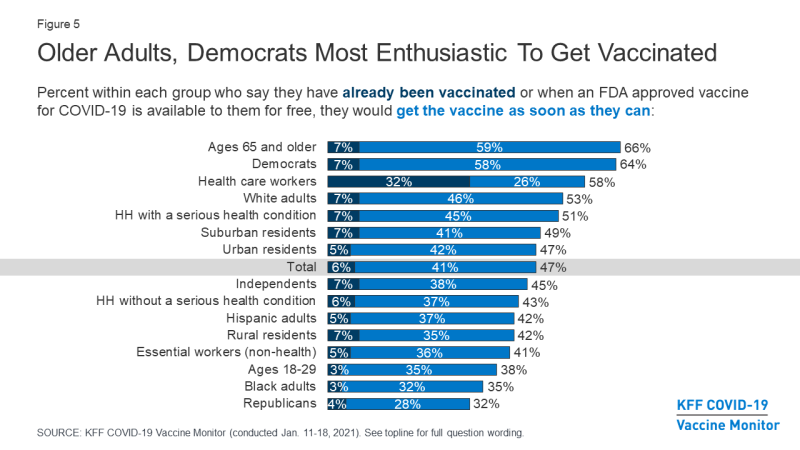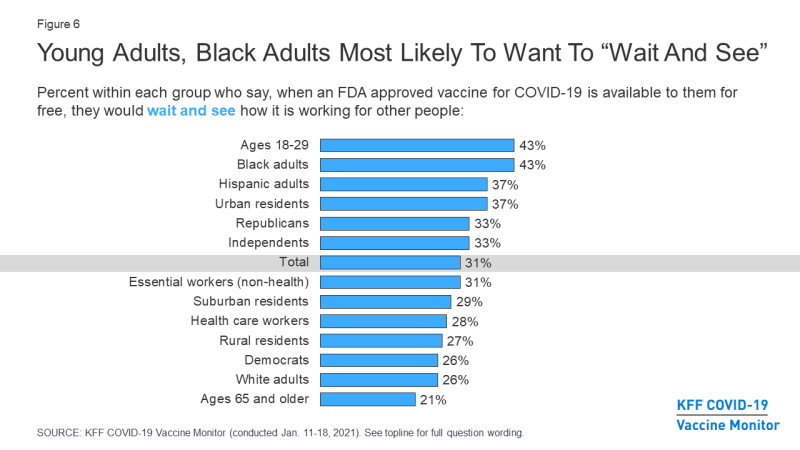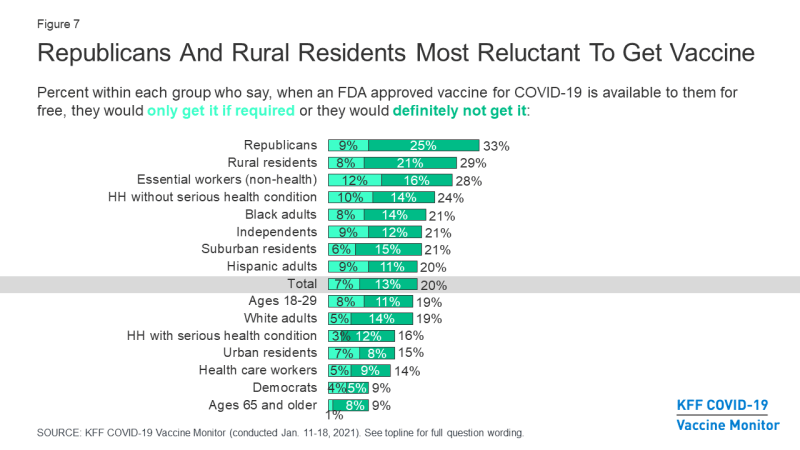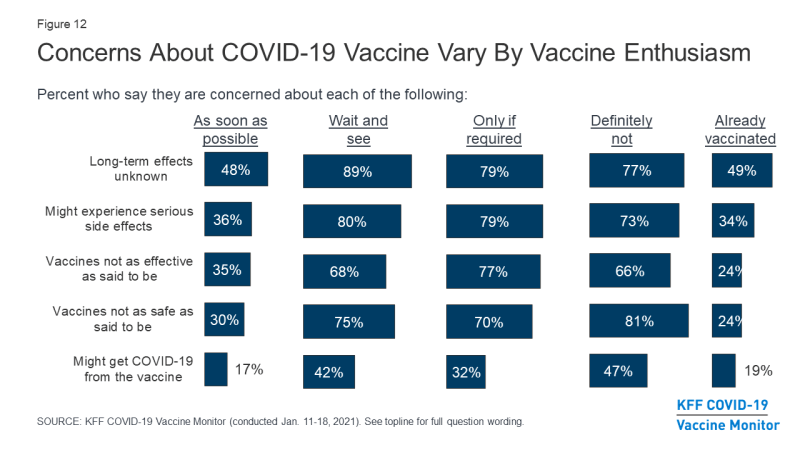KFF COVID-19 Vaccine Monitor: January 2021
Vaccine Hesitancy
These additional findings were released January 27, 2021.
The KFF COVID-19 Vaccine Monitor is an ongoing research project tracking the public’s attitudes and experiences with COVID-19 vaccinations. Using a combination of surveys and qualitative research, this project tracks the dynamic nature of public opinion as vaccine development and distribution unfold, including vaccine confidence and hesitancy, trusted messengers and messages, as well as the public’s experiences with vaccination.
Key Findings
- As millions of Americans get their first and second doses of a COVID-19 vaccine, the latest KFF COVID-19 Vaccine Monitor reports that a growing share of the public is open to getting vaccinated, but many of the same groups that were hesitant in December remain hesitant now. The share of U.S. adults who want to get the vaccine as soon as possible has increased since December among Black, Hispanic, and White adults alike, and the share who say they want to “wait and see” how it works for other people has declined. Similarly, vaccine enthusiasm has shifted among those living in urban, suburban, and rural communities, but rural residents continue to be among the most resistant to getting vaccinated.
- Partisanship continues to be a factor in attitudes towards COVID-19 vaccination. While vaccine enthusiasm increased for both Democrats and independents, it has not shifted among Republicans, who remain the most resistant, with 33% saying they will definitely not get the vaccine or will get it only if required to do so for work, school or other activities.
- Racial and economic equity remains at the forefront of the COVID-19 vaccine conversation. Black and Hispanic adults and those with lower incomes are less likely than their White and higher-income counterparts to say they have personally received at least one dose of the vaccine or that they know someone who has. Black and Hispanic adults are also among those most likely to say they want to “wait and see” how the vaccine is working for other people before getting vaccinated themselves.
- Knowing someone who has been vaccinated for COVID-19 is correlated with vaccine hesitancy and enthusiasm. Among those who say they want the vaccine “as soon as possible,” about half (52%) know someone who has been vaccinated, while among those who say they’ll get it “only if required,” a much smaller share (29%) know someone who has received the vaccine.
- Those who have not yet been vaccinated for COVID-19 have many concerns and information needs related to the new vaccines, particularly when it comes to side effects and the effectiveness of the vaccine. About half say they don’t have enough information about the vaccine’s side effects or effectiveness, with higher shares of younger, Black, and Hispanic adults citing these information needs.
- When examining messages and information that might increase the public’s willingness to get vaccinated, the messages the public finds the most convincing emphasize the vaccine’s effectiveness at preventing illness, protection for those who are vaccinated, and the ability to return to normal life. On the other hand, hearing that some people experience short-term side effects from the vaccine or that a small number of people have experienced serious allergic reactions has the potential to decrease willingness to get vaccinated for a substantial share of people.
- Reinforcing previous findings about trusted sources of information, the survey finds that doctors, nurses, and other health care providers are the sources that people say they’re most likely to turn to when making their own decisions about whether to get vaccinated. Still, these conversations have not started yet for many, with only about a quarter (26%) saying they have asked a health care professional for information about the vaccine so far.
COVID-19 Vaccine Hesitancy and Enthusiasm
Trends in Hesitancy and Enthusiasm
With millions of Americans having received at least one dose of a COVID-19 vaccine, the latest KFF COVID-19 Vaccine Monitor (fielded just before President Biden took office) reports that enthusiasm for getting vaccinated has increased markedly since December. Four in ten U.S. adults (41%) now say that when an FDA-approved vaccine for COVID-19 is available to them for free, they will get the vaccine “as soon they can,” up from 34% in December. An additional 6% say they have already received at least one dose of the vaccine1, bringing the total in this “as soon as possible” group to nearly half the public (47%). About three in ten (31%) say they want to “wait until it has been available for a while to see how it is working for other people” before getting the COVID-19 vaccine themselves, down from 39% in December. One in five adults are more reluctant to get vaccinated, including 7% who say they will get the vaccine only “if they are required to do so for work, school, or other activities” and 13% who say they will “definitely not” get the vaccine.
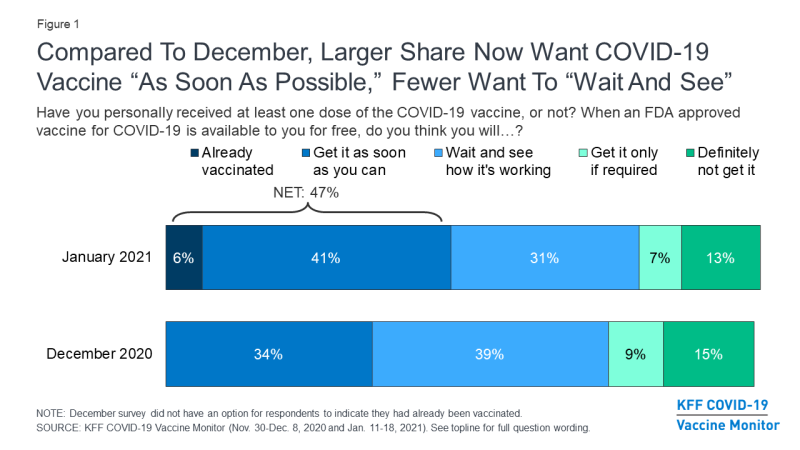
Figure 1: Compared To December, Larger Share Now Want COVID-19 Vaccine “As Soon As Possible,” Fewer Want To “Wait And See”
The share of U.S. adults who want to get the vaccine as soon as possible has increased since December among Black, Hispanic, and White adults alike, and the share who say they want to “wait and see” how it works for other people has declined among Black and White adults. However, Black adults (43%) and Hispanic adults (37%) remain significantly more likely than White adults (26%) to say they want to “wait and see,” while White adults (53%) are more likely to say they have already been vaccinated or want the vaccine “as soon as possible” compared Black or Hispanic adults (35% and 42%, respectively).
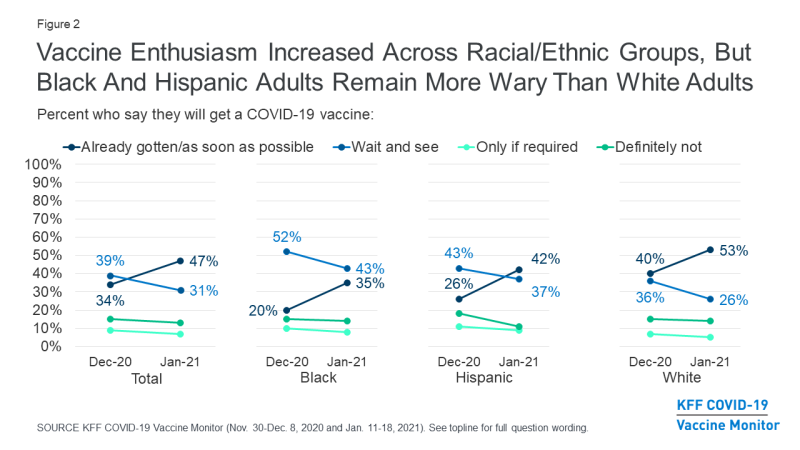
Figure 2: Vaccine Enthusiasm Increased Across Racial/Ethnic Groups, But Black And Hispanic Adults Remain More Wary Than White Adults
Similarly, there has been a shift in COVID-19 vaccine enthusiasm across different types of communities, including in urban, suburban, and rural areas. Among rural residents, 42% now say they have either already been vaccinated or want the vaccine “as soon as possible” and 27% want to “wait and see” how it’s working, essentially reversed from December when 29% said “as soon as possible” and 38% said “wait and see.” Still, rural residents remain much more likely than those living in urban areas to say they will “definitely not” take the vaccine (21% vs. 8%).
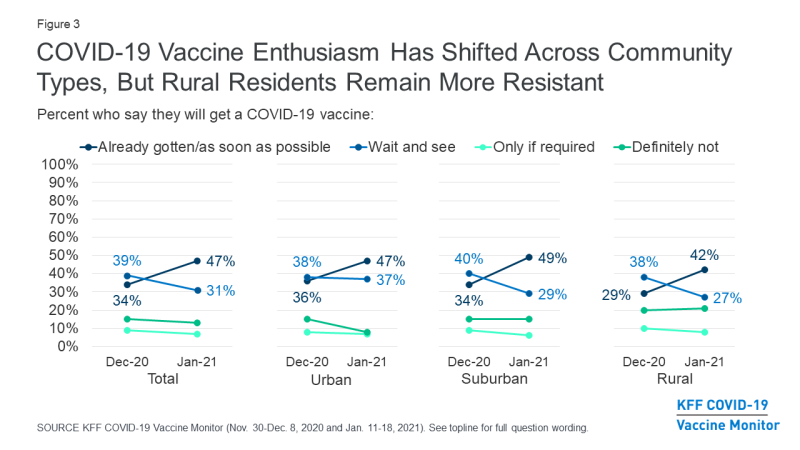
Figure 3: COVID-19 Vaccine Enthusiasm Has Shifted Across Community Types, But Rural Residents Remain More Resistant
Politically, the shift in COVID-19 vaccine enthusiasm between December and January was driven almost entirely by Democrats (and to a lesser extent, independents). Nearly two-thirds of Democrats (64%) now say they have either already been vaccinated or want the vaccine as soon as possible, up from 47% in December, and the share of independents who fall into this group increased from 30% to 45%. Republicans remain the least enthusiastic group, with 32% saying they have already been vaccinated or want the vaccine as soon as they can, 33% saying they want to wait and see how it works for others, and 25% saying they will definitely not get the vaccine, similar to the December results.
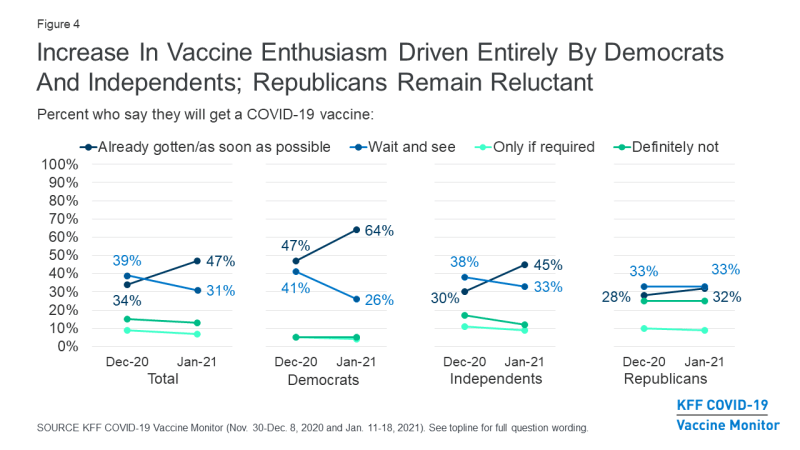
Figure 4: Increase In Vaccine Enthusiasm Driven Entirely By Democrats And Independents; Republicans Remain Reluctant
Which Groups Are Most Enthusiastic/Hesitant/Resistant?
Who is most enthusiastic to get vaccinated against the novel coronavirus? Adults ages 65 and over (66%) and Democrats (64%) are among those most likely to say that they have already gotten the vaccine or that they will get it “as soon as they can.” Those who work in a health care delivery setting (58%), White adults (53%) and those who live in households where someone has a serious health condition (51%) are also more likely than their counterparts to say they have been vaccinated already or want the vaccine “as soon as possible.”
Who is most likely to say they want to wait to see how vaccination goes for other people before getting vaccinated themselves? Young adults ages 18-29 (43%), Black adults (43%), Hispanic adults (37%), and those living in urban areas (37%) are the most likely to say they want to “wait and see” how the COVID-19 vaccine is working for other people before getting vaccinated themselves.
One in five U.S. adults overall say they will either “definitely not” get vaccinated or that they’ll get vaccinated “only if required” for work, school, or other activities. One-third (33%) of Republicans fall into one of these most reluctant categories, as do about three in ten rural residents (29%) and a similar share of essential workers in fields other than health care (28%).
Health Care Workers and Other Essential Workers
One priority group for early COVID-19 vaccination is essential workers – those who are required to work outside their home during the pandemic – including those who work in health care delivery settings. Twelve percent of all essential workers, including 32% of health care workers and 5% of non-health essential workers, say they have received at least one dose of the vaccine. Still, substantial hesitation remains even among these priority groups. Three in ten non-health essential workers (31%), and a similar share of health care workers (28%) say they want to wait and see how the vaccine is working for other people before getting it themselves. Among essential workers in fields other than health care, 12% say they’ll get the vaccine only if required, and 16% say they will definitely not get it, though these shares are somewhat smaller among health care workers (5% and 9%, respectively).
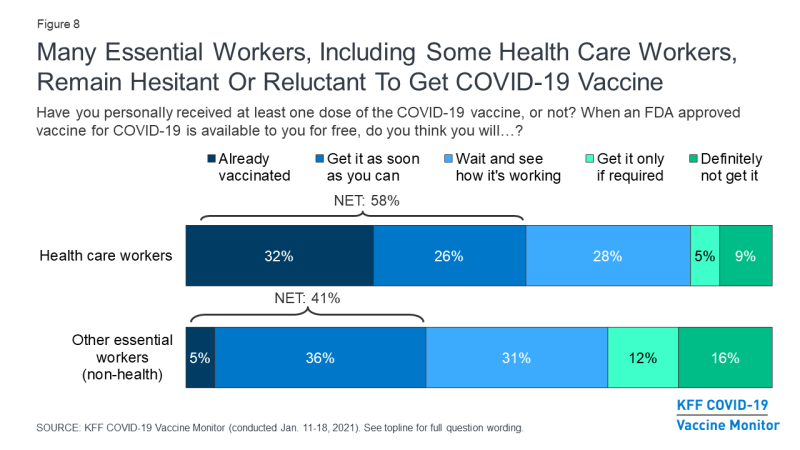
Figure 8: Many Essential Workers, Including Some Health Care Workers, Remain Hesitant Or Reluctant To Get COVID-19 Vaccine
Personal Experiences With Vaccination
At the time the survey was fielded, access to the COVID-19 vaccine in most states was limited to health care workers and long-term care workers, and some states had begun to open up access to other groups including older adults, other front-line workers, and those with certain health conditions. While just 6% of U.S. adults say they have personally received at least one dose of the COVID-19 vaccine, an additional 41% say they know someone who has been vaccinated. However, this proximity to vaccination is unevenly distributed across demographic groups. White adults (51%) are more likely than their Black and Hispanic counterparts (38% and 37%, respectively) to say they’ve either been vaccinated or know someone who has. Further, those with household incomes of $90,000 or more are almost twice as likely as those with incomes under $40,000 to say that they or someone they know has been vaccinated (65% vs. 33%). These patterns are consistent with a recent KFF analysis that found that the shares of vaccinations among Black and Hispanic people were lower compared to their shares of the total population in most states where data were reported by race and ethnicity.
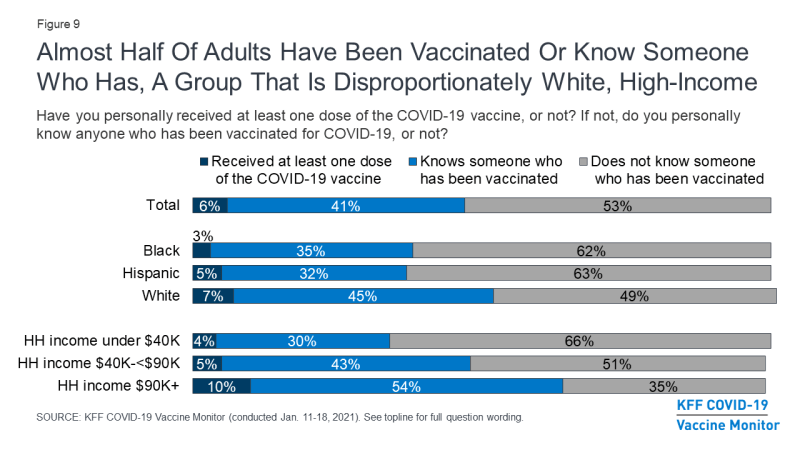
Figure 9: Almost Half Of Adults Have Been Vaccinated Or Know Someone Who Has, A Group That Is Disproportionately White, High-Income
Knowing someone who has been vaccinated for COVID-19 is also correlated with vaccine hesitancy and enthusiasm among those who have not yet been vaccinated themselves. Among those who say they want the vaccine “as soon as possible,” about half (52%) know someone who has been vaccinated, while among those who say they’ll get it “only if required,” a much smaller share (29%) know someone who has received the vaccine.

Figure 10: Knowing Someone Who Has Been Vaccinated For COVID-19 Is Correlated With Vaccine Enthusiasm
Concerns and Information Needs
Concerns About COVID-19 Vaccines
Understanding the concerns or reservations that people have about vaccines can be helpful for crafting effective messages to convince people to get vaccinated. Asked about a variety of things they might be concerned about, the most common concern among U.S. adults who have not yet been vaccinated is that “the long-term effects of the COVID-19 vaccines are unknown” (68% say they are “very” or “somewhat” concerned about this). Majorities are also concerned that they might experience serious side effects from the vaccine (59%), that the vaccines are not as safe as they are said to be (55%), or that they are not as effective as they are said to be (53%). Fewer (31%) say they concerned that they might get COVID-19 from the vaccine.
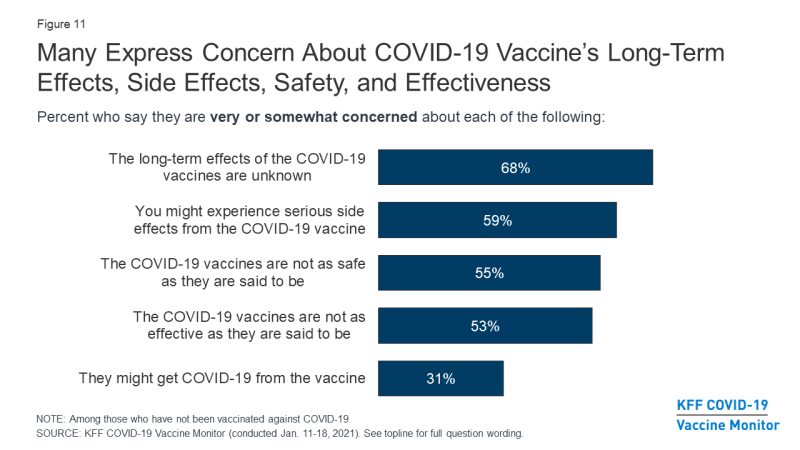
Figure 11: Many Express Concern About COVID-19 Vaccine’s Long-Term Effects, Side Effects, Safety, and Effectiveness
Concerns about safety and side effects are highest among those who want to wait and see how the vaccine is working for others as well as those who are more reluctant to get vaccinated. Among the “wait and see” group that is closely watching how things go for others during the initial vaccine rollout, nine in ten (89%) are concerned about the long-term effects of the vaccine, eight in ten are concerned they may experience serious side effects, three-quarters are concerned the vaccines are not as safe as they are said to be, and two-thirds (68%) are concerned they might not be as effective as claimed.
Still, concerns about the vaccine are not completely absent for those who are eager to get vaccinated, or even those who have already received at least one dose of the vaccine. Notably, about half of those who have already received at least one dose (49%) and a similar share of those who say they want the vaccine as soon as possible (48%) say they are at least somewhat concerned that the long-term effects of the COVID-19 vaccines are unknown.
Echoing previous findings that different groups have different reasons for being hesitant to get vaccinated, the January KFF COVID-19 Vaccine Monitor reports that different groups express different levels of concern about side effects, safety, and effectiveness as well. For example, among those who have not yet been vaccinated, about half of Black (54%) and Hispanic adults (50%) say they are concerned they might get COVID-19 from the vaccine, compared to a much smaller share of White adults (20%). Black and Hispanic adults are also more likely than White adults to express nearly every concern measured in the survey, with large shares of Black adults saying they are concerned that the long-term effects of the vaccine are unknown (86%), that they might experience serious side effects (75%), and that the vaccines may not be as safe (75%) or effective (71%) as they are said to be. Those with lower incomes and those who have not graduated from college are also more likely to express each of these concerns compared to their higher-income and more educated counterparts, and larger shares of women than men are concerned about each of these things.
| Table 1: Concerns About A COVID-19 Vaccine Among Those Who Have Not Yet Been Vaccinated By Income, Race/Ethnicity, Education And Gender | |||||||||||
| Percent who say they are very or somewhat concerned about each of the following: | Total | Household income | Race/Ethnicity | Education | Gender | ||||||
| >$40K | $40K- >$90K | $90K+ | Black | Hisp. | White | Less than College | College+ | Men | Women | ||
| The long-term effects of the COVID-19 vaccines are unknown | 68% | 77% | 72% | 55% | 86% | 74% | 63% | 73% | 58% | 63% | 74% |
| They might experience serious side effects from the COVID-19 vaccine | 59 | 69 | 62 | 44 | 75 | 68 | 52 | 64 | 47 | 51 | 67 |
| The COVID-19 vaccines are not as safe as they are said to be | 55 | 66 | 59 | 37 | 75 | 61 | 49 | 60 | 42 | 47 | 64 |
| The COVID-19 vaccines are not as effective as they are said to be | 53 | 68 | 51 | 36 | 71 | 66 | 46 | 59 | 40 | 47 | 60 |
| They might get COVID-19 from the vaccine | 31 | 45 | 27 | 15 | 54 | 50 | 20 | 36 | 18 | 23 | 39 |
| NOTE: Based on those who say they have not yet been vaccinated (94% of adults). | |||||||||||
Information and Misinformation
Echoing the public’s concerns about side effects and effectiveness, nearly six in ten (57%) of those who have not been vaccinated against COVID-19 say they don’t have enough information about the potential side effects of the vaccine, and about half (49%) say they don’t know enough about the vaccine’s effectiveness. Notably, these information needs are substantially higher among those who say they are waiting to see how the vaccine works for others and those who say they will get vaccinated only if required. Just over three-quarters in both these groups say they don’t have enough information about the vaccine’s side effects, and about seven in ten say they don’t know enough about its effectiveness.
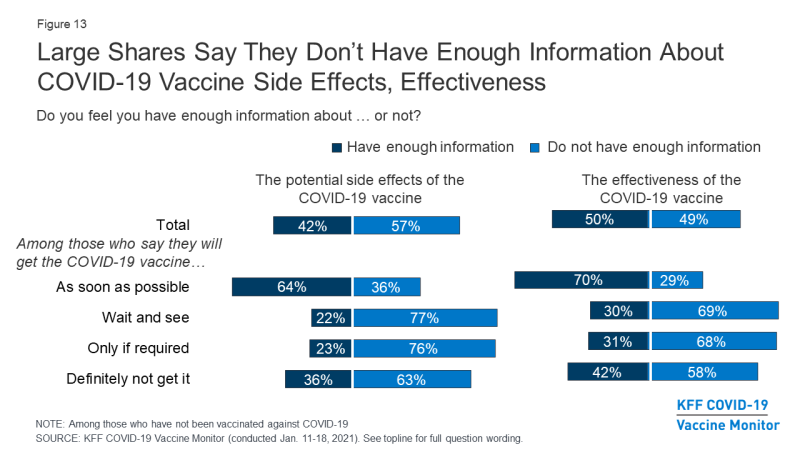
Figure 13: Large Shares Say They Don’t Have Enough Information About COVID-19 Vaccine Side Effects, Effectiveness
Information needs about COVID-19 vaccine side effects and effectiveness are higher among younger adults and those who are Black or Hispanic. Among Black and Hispanic adults who have not been vaccinated, about two-thirds say they don’t have enough information about the side effects of the vaccine and about six in ten say the same about the vaccine’s effectiveness. Among those under age 50, roughly six in ten say they don’t know enough about side effects and more than half need more information about effectiveness.
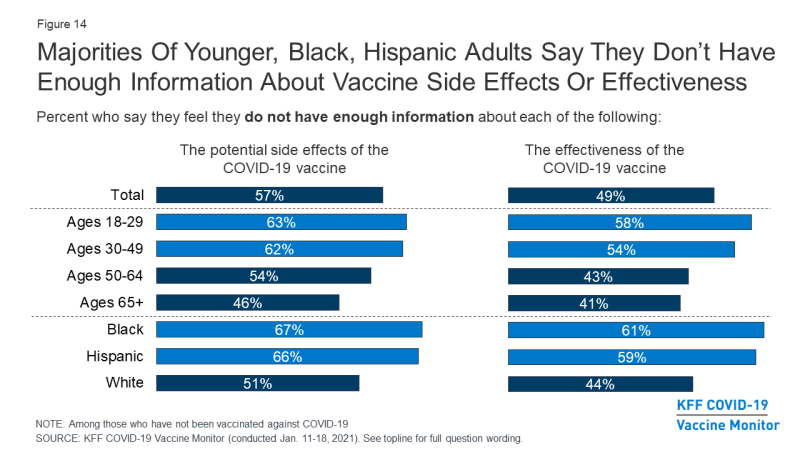
Figure 14: Majorities Of Younger, Black, Hispanic Adults Say They Don’t Have Enough Information About Vaccine Side Effects Or Effectiveness
Information needs also vary by education and income. Among adults with a high school education or less, 63% say they don’t know enough about the COVID-19 vaccine side effects and 57% say they lack information about its effectiveness. Similarly, among those with household incomes under $40,000, two-thirds say they don’t have enough information about side effects and six in ten (61%) don’t know enough about effectiveness.
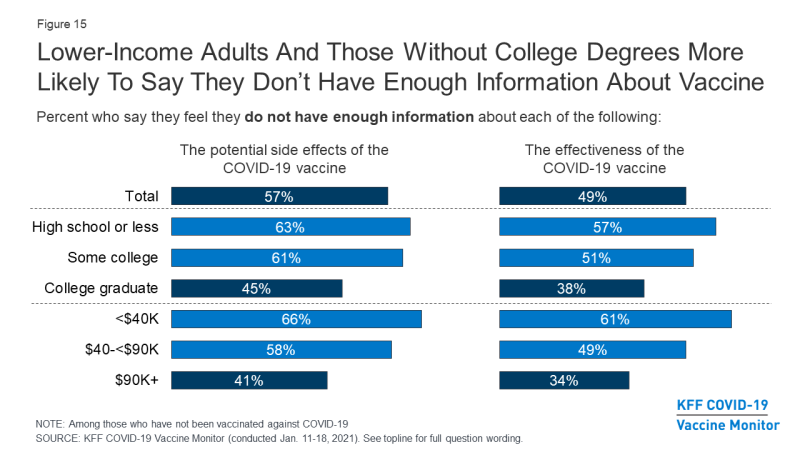
Figure 15: Lower-Income Adults And Those Without College Degrees More Likely To Say They Don’t Have Enough Information About Vaccine
The Vaccine Monitor also reports that some of those who have not yet been vaccinated have heard misinformation about the COVID-19 vaccines and either believe it to be true or are unsure whether it is true or false. Most commonly, 8% of those who haven’t been vaccinated believe the vaccines currently being distributed contain the live virus that causes COVID-19, and an additional 11% say they’ve heard this and are unsure if it’s true. Small shares also believe or are unsure whether the COVID-19 vaccines have been shown to cause infertility (13%) or whether getting vaccinated requires paying an out-of-pocket cost (12%). Overall, one-third (34%) of those who have not been vaccinated believe or are unsure about at least one of these things.
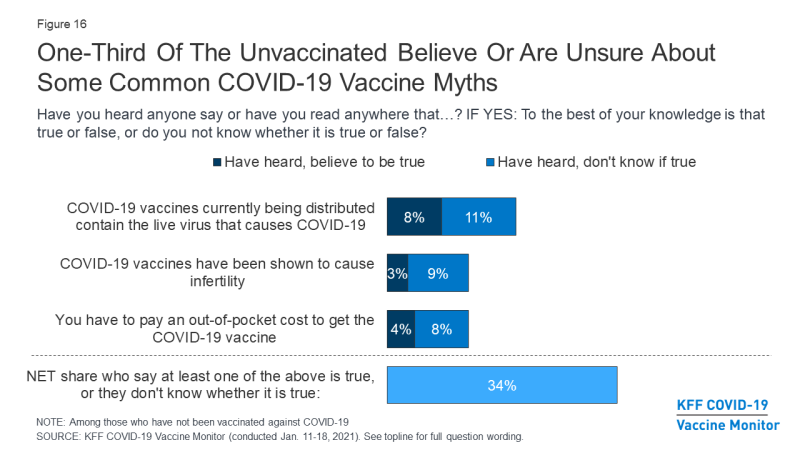
Figure 16: One-Third Of The Unvaccinated Believe Or Are Unsure About Some Common COVID-19 Vaccine Myths
Notably, the share who believe or are unsure about at least one of these vaccine “myths” (that the vaccine contains the live coronavirus, that it causes infertility, or that an out-of-pocket cost is required to get vaccinated) is higher among those who want to “wait and see” how the vaccine works for other people (41%) and those who say they will “definitely not” get vaccinated (53%). These shares also vary by education level; 37% of those without a college degree believe or are unsure about at least one of these things, compared with 28% of college graduates.
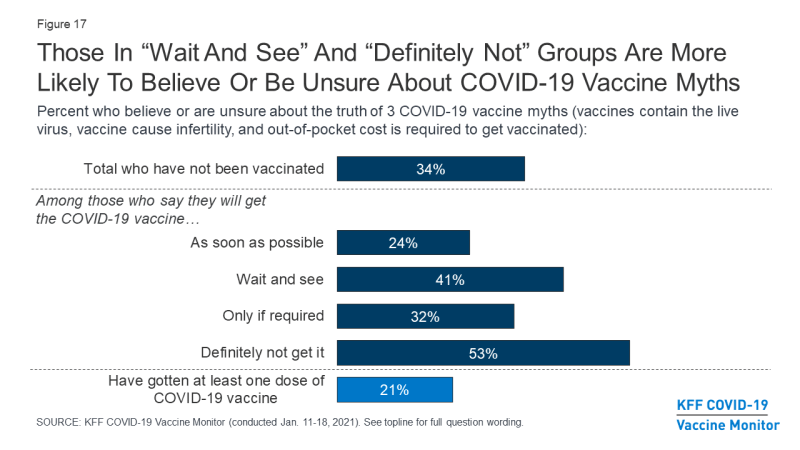
Figure 17: Those In “Wait And See” And “Definitely Not” Groups Are More Likely To Believe Or Be Unsure About COVID-19 Vaccine Myths
On the other hand, about half (47%) of those who have not been vaccinated know that people will still need to wear face masks after getting vaccinated to help limit the spread of coronavirus, though this level of awareness is somewhat lower among the groups that are move hesitant to get vaccinated (36% in both the “wait and see” and “only if required” groups and 35% in the “definitely not” group).
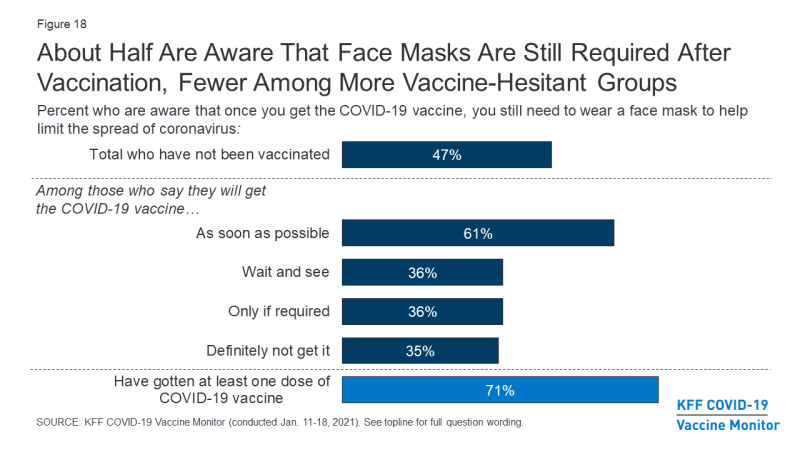
Figure 18: About Half Are Aware That Face Masks Are Still Required After Vaccination, Fewer Among More Vaccine-Hesitant Groups
How Messages And Information Affect Willingness To Get Vaccinated For COVID-19
Messages and Information That Might Convince People To Get Vaccinated
The latest COVID-19 Vaccine Monitor tested different messages and information that might make people more likely to get vaccinated for COVID-19, and found that the messages the public finds the most convincing emphasize the vaccine’s effectiveness, protection from illness, and the ability to return to normal life. Among those who have not yet been vaccinated, majorities say they would be more likely to get a vaccine if they heard it was “highly effective” in preventing illness from COVID-19 (57%), that getting vaccinated offers protection from getting sick (56%), and that the vaccine offers “the quickest way for life to return to normal” (54%). Over four in ten say they would be more likely to get vaccinated if they heard that “millions of people have already safely been vaccinated” (46%) and that vaccination is needed to “get the U.S. economy back on track” (45%). Somewhat fewer said that knowing the vaccine is free (36%) or hearing that a doctor or health care provider they trust (38%) or a close friend or family member (32%) got vaccinated would make them more likely to get vaccinated themselves.

Figure 19: Most Convincing Messages Emphasize Vaccine Effectiveness, Protection From Illness, And Return To Normal Life
Among the important “wait and see” group that is the best target for converting from vaccine hesitant to vaccine enthusiastic, the most convincing messages are similar to those for the public overall. Two-thirds (67%) of this group says hearing that the vaccine will help protect them from getting sick would make them more likely to get vaccinated, and 64% say the same thing about hearing that the vaccines are highly effective. The same share (64%) say they would be more likely to get vaccinated after hearing that vaccination offers the quickest return to normal live. Few in the “definitely not” group say they’d be convinced by any of the messages tested, reflecting the daunting challenge of addressing reluctance to get vaccinated among this group.
| Table 2: Responses To Pro-Vaccine Messages And Information By COVID-19 Vaccine Enthusiasm | ||||||
| Percent who say that hearing each of the following would make them more likely to get vaccinated: | Total | Get it as soon as you can | Wait and see | Get it only if required | Definitely will not get | |
| The vaccines have been shown to be highly effective in preventing illness from COVID-19 | 57% | 64% | 66% | 54% | 18% | |
| The vaccine will help protect you from getting sick from COVID-19 | 56 | 67 | 62 | 41 | 14 | |
| The quickest way for life to return to normal is for most people to get vaccinated | 54 | 64 | 62 | 48 | 12 | |
| Millions of people have already safely been vaccinated for COVID-19 | 46 | 55 | 51 | 43 | 8 | |
| We need people to get vaccinated to get the U.S. economy back on track | 45 | 55 | 48 | 47 | 11 | |
| A doctor or health care provider you trust has gotten the vaccine | 38 | 49 | 38 | 34 | 7 | |
| There is no cost to get the vaccine | 36 | 46 | 38 | 32 | 3 | |
| A close friend or family member got vaccinated for COVID-19 | 32 | 39 | 37 | 29 | 3 | |
| NOTE: Asked among those who say they have not yet been vaccinated (94% of adults). | ||||||
Whether people find pro-vaccine messages and information convincing also varies by demographic group and by partisan identification. For example, larger shares of Black and Hispanic adults compared to White adults say they would be more likely to get vaccinated after hearing most messages tested in the survey. In particular, Hispanic adults are much more likely than White adults to report increased likelihood of getting vaccinated after hearing that there is no cost to get vaccinated (54% vs. 32%) or that a friend or family member (53% vs. 26%) or a health care provider they trust (51% vs. 34%) got the vaccine. Young adults ages 18-29 are also more likely than their older counterparts to say they’d be more likely to get vaccinated after hearing there is no cost (48%) or that a close friend or family member got vaccinated (41%).
Republicans are less likely than Democrats and independents to say that each message tested would make them more likely to get vaccinated. Despite many polls showing Republicans are concerned about reviving the U.S. economy, 30% of Republicans say they would be more likely to get vaccinated after hearing that getting people vaccinated will help get the economy back on track, compared to 57% of Democrats and 47% of independents.
| Table 3: Responses To Pro-Vaccine Messages And Information By Race/Ethnicity, Age, Party Identification | |||||||||||||
| Percent who say that hearing each of the following would make them more likely to get vaccinated: | Total | Age | Race/Ethnicity | Party ID | |||||||||
| 18-29 | 30-49 | 50-64 | 65+ | Black | Hisp. | White | Dem. | Ind. | Rep. | ||||
| The vaccines have been shown to be highly effective in preventing illness from COVID-19 | 57% | 67% | 57% | 49% | 55% | 58% | 69% | 53% | 67% | 59% | 43% | ||
| The vaccine will help protect you from getting sick from COVID-19 | 56 | 62 | 56 | 49 | 57 | 61 | 71 | 50 | 67 | 57 | 42 | ||
| The quickest way for life to return to normal is for most people to get vaccinated | 54 | 62 | 52 | 46 | 60 | 61 | 69 | 49 | 67 | 55 | 37 | ||
| Millions of people have already safely been vaccinated for COVID-19 | 46 | 55 | 46 | 41 | 42 | 50 | 65 | 39 | 57 | 48 | 29 | ||
| We need people to get vaccinated to get the U.S. economy back on track | 45 | 50 | 43 | 41 | 49 | 51 | 63 | 40 | 57 | 47 | 30 | ||
| A doctor or health care provider you trust has gotten the vaccine | 38 | 44 | 41 | 31 | 36 | 43 | 51 | 34 | 48 | 40 | 24 | ||
| There is no cost to get the vaccine | 36 | 48 | 36 | 32 | 28 | 33 | 54 | 32 | 44 | 39 | 21 | ||
| A close friend or family member got vaccinated for COVID-19 | 32 | 41 | 34 | 29 | 26 | 35 | 53 | 26 | 42 | 33 | 20 | ||
| NOTE: Asked among those who say they have not yet been vaccinated (94% of adults). | |||||||||||||
Messages and Information That Might Deter People From Getting Vaccinated
Just as messaging can help convince people to get vaccinated, the public may also hear things that would make them less eager to get a COVID-19 vaccine. In the Monitor we report on a few of these messages and find that hearing about rare allergic reactions and short-term side effects may increase vaccine hesitancy for some. Overall, 39% of those who have not yet been vaccinated say that hearing that “a small number of people have experienced a serious allergic reaction” to the vaccine would make them less likely to get vaccinated, and 33% say the same after hearing that some-people experience “short-term side effects like pain or fever.” Fewer say they would be deterred after hearing that masks and social distancing will still be required after getting vaccinated (20% say this would make them less likely) or that two vaccine doses are required (18%).
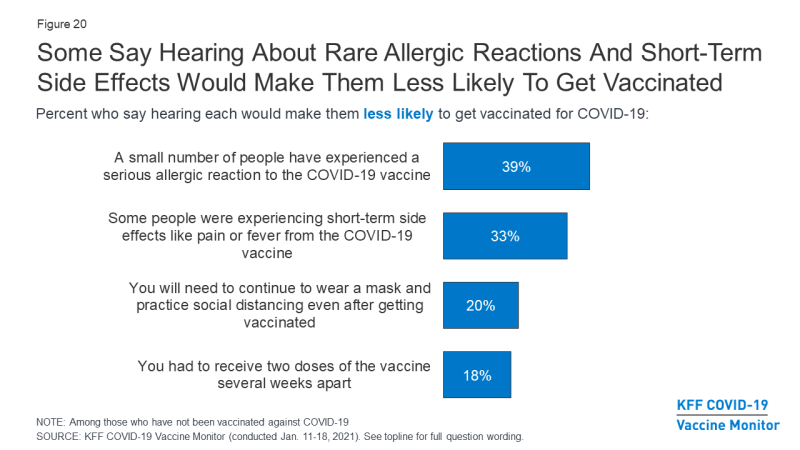
Figure 20: Some Say Hearing About Rare Allergic Reactions And Short-Term Side Effects Would Make Them Less Likely To Get Vaccinated
Of particular concern, six in ten of those who want to “wait and see” how the vaccine is working say hearing about rare allergic reactions would make them “less likely” to get vaccinated, and half of this group says the same about hearing of short-term side effects.
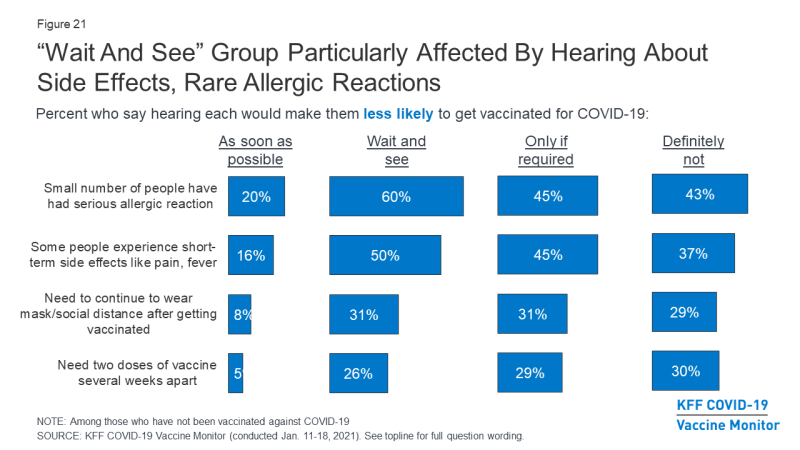
Figure 21: “Wait And See” Group Particularly Affected By Hearing About Side Effects, Rare Allergic Reactions
About half of Black and Hispanic adults also say that hearing about short-term side effects and rare allergic reactions to the COVID-19 vaccine would make them less likely to get vaccinated. While one in five adults overall (18%) say that learning they would need to receive two doses of the vaccine several weeks apart would make them less likely to get vaccinated, about a quarter of Hispanic adults (28%), Black adults (26%), and those with household incomes under $40,000 (26%) say this is the case.
| Table 4: Response To Negative Vaccine Messages And Information By Race/Ethnicity And Income | ||||||||
| Percent who say that hearing each of the following would make them less likely to get vaccinated: | Total | Race/Ethnicity | Household Income | |||||
| Black | Hispanic | White | >$40K | $40K- >$90K | $90K+ | |||
| A small number of people have experienced a serious allergic reaction to the COVID-19 vaccine | 39% | 49% | 50% | 32% | 48% | 38% | 27% | |
| Some people were experiencing short-term side effects like pain or fever from the COVID-19 vaccine | 33 | 46 | 46 | 23 | 43 | 32 | 17 | |
| You will need to continue to wear a mask and practice social distancing even after getting vaccinated | 20 | 26 | 27 | 16 | 27 | 19 | 15 | |
| You had to receive two doses of the vaccine several weeks apart | 18 | 26 | 28 | 12 | 26 | 17 | 7 | |
| NOTE: Asked among those who say they have not yet been vaccinated (94% of adults). | ||||||||
Who Will The Public Turn To When Making Decisions About Whether To Get Vaccinated?
Echoing previous findings about trusted sources of information on COVID-19 vaccination, the latest survey finds that 79% of U.S. adults who have not yet been vaccinated say they would be likely to turn to a doctor, nurse, or other health care provider when deciding whether to get a vaccination, including almost half (46%) who say they would be “very likely.” About six in ten say they’d be likely to turn to other sources such as the U.S. Centers for Disease Control and Prevention (CDC) (60%), family or friends (58%), their state or local health department (57%), or a pharmacist (54%). Few say they’d turn to a religious leader such as a priest, rabbi, or minister (17%).
Despite the fact that health care providers are the source people say they are most likely to turn to for vaccine information, relatively few (24%) of those who have not yet been vaccinated say they have already asked a doctor or other health care professional for information about the vaccine, a share that rises to 32% among those who say they want to get vaccinated “as soon as possible.”
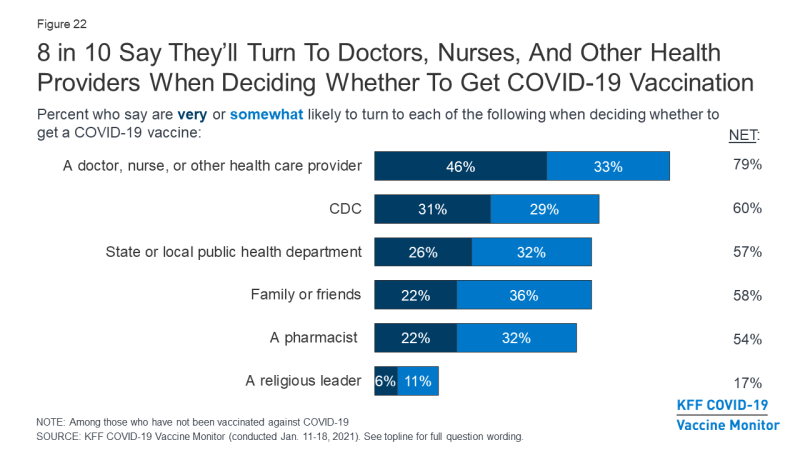
Figure 22: 8 in 10 Say They’ll Turn To Doctors, Nurses, And Other Health Providers When Deciding Whether To Get COVID-19 Vaccination
Health care providers are the top source that Americans say they’ll turn to for help with vaccine decision-making across demographic groups. However, there are some differences in how different groups plan to use other sources in making this decision. For example, larger shares of Black and Hispanic adults, as well as young adults ages 18-29, say they’re likely to turn to the CDC or their state and local health department, reflecting partisan differences in how these sources of information are viewed. Further, a larger share of Black adults (33%) and Hispanic adults (29%) say they will turn to a religious leader for help with this decision compared to White adults (11%), suggesting a potential pathway for information delivery that could be productive with some communities of color.
| Table 5: Likely Sources of COVID-19 Vaccine Information By Age. Race/Ethnicity And Party Identification | |||||||||||||
| Percent who say that, when deciding whether to get a COVID-19 vaccine, they are very or somewhat likely to turn to each of the following for information: | Total | Age | Race/Ethnicity | Party ID | |||||||||
| 18-29 | 30-49 | 50-64 | 65+ | Black | Hisp. | White | Dem. | Ind. | Rep. | ||||
| A doctor, nurse, or other health care provider | 79% | 82% | 80% | 77% | 79% | 84% | 81% | 77% | 85% | 80% | 72% | ||
| The Centers for Disease Control and Prevention (CDC) | 60 | 78 | 64 | 51 | 46 | 71 | 69 | 55 | 74 | 64 | 39 | ||
| Family or friends | 58 | 62 | 56 | 57 | 58 | 61 | 63 | 56 | 64 | 57 | 54 | ||
| Their state or local public health department | 57 | 68 | 57 | 50 | 55 | 71 | 73 | 51 | 73 | 59 | 37 | ||
| A pharmacist | 54 | 56 | 55 | 51 | 55 | 65 | 57 | 52 | 63 | 54 | 48 | ||
| A religious leader such as minister, pastor, priest, or rabbi | 17 | 12 | 17 | 18 | 22 | 33 | 29 | 11 | 17 | 17 | 16 | ||
| NOTE: Asked among those who say they have not yet been vaccinated (94% of adults). | |||||||||||||

